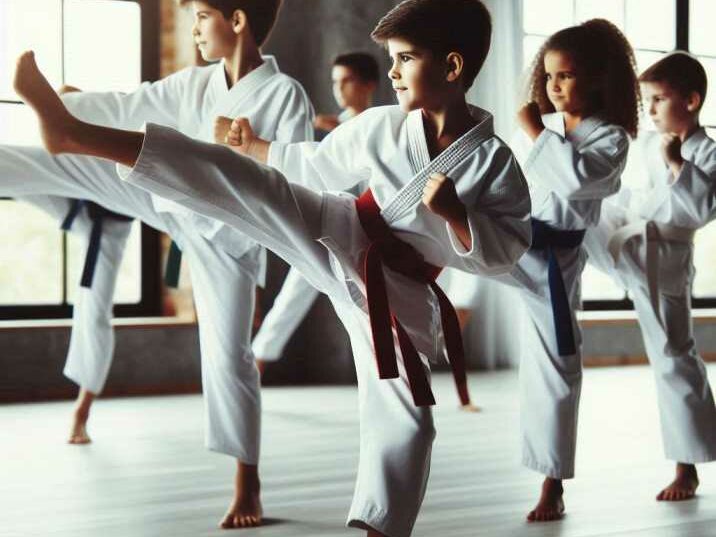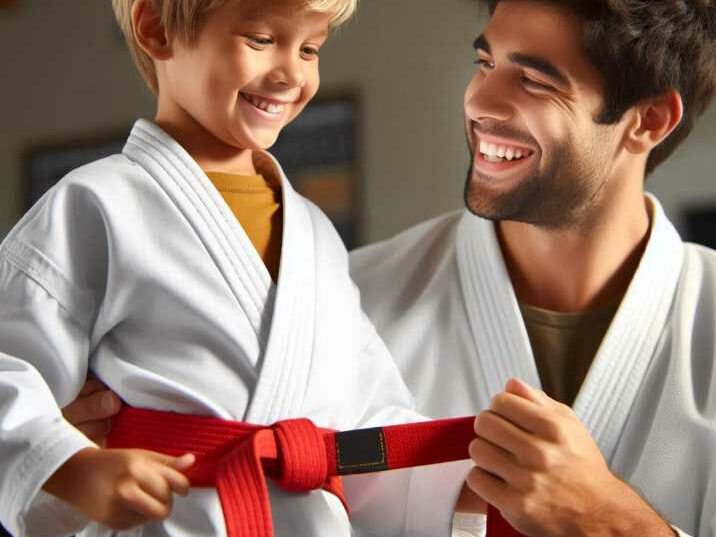Maintaining a healthy weight is essential for children, as it sets the foundation for a lifetime of good health. One exciting and effective way to promote healthy weight management in kids is through martial arts. This ancient practice combines physical exercise with self-defense techniques, providing numerous benefits for young minds and bodies. In this article, we will explore how martial arts can be a fun and engaging way for children to stay fit, build confidence, and develop valuable life skills.

Table of Contents
Table of Contents
- Introduction
- Benefits of Martial Arts for Kids
- Physical Fitness
- Mental and Emotional Benefits
- Social Skills Development
- Types of Martial Arts for Kids
- Karate
- Taekwondo
- Judo
- Brazilian Jiu-Jitsu
- How Martial Arts Help with Weight Management
- Calorie Burning
- Muscle Building
- Improved Metabolism
- Making Fun with Martial Arts for Kids
- Interactive Classes
- Goal Setting and Rewards
- Involvement of Parents
- Conclusion
- FAQs
Introduction
Martial arts are a collection of ancient practices and traditions that combine physical exercise with self-defense techniques. For kids, martial arts offer a dynamic and enjoyable way to stay active. They not only help in maintaining a healthy weight but also foster discipline, respect, and self-confidence. In the United States, childhood obesity is a growing concern, with nearly 1 in 5 school-aged children being classified as obese. Introducing kids to martial arts can be a proactive step toward combating this issue, promoting a healthier lifestyle, and instilling lifelong habits of physical activity and wellness.
Benefits of Martial Arts for Kids
Physical Fitness
Martial arts are a full-body workout, engaging various muscle groups and promoting cardiovascular health. Children who participate in martial arts can improve their strength, flexibility, and endurance. The repetitive nature of martial arts movements, such as kicking, punching, and grappling, helps kids develop strong muscles and enhance their coordination. Regular practice can lead to improved agility and balance, making martial arts an excellent choice for overall physical fitness.
Strength and Endurance
Martial arts routines involve intense physical activity that builds muscular strength and endurance. Techniques such as kicking and striking require significant muscle engagement, particularly in the legs, core, and upper body. Over time, children develop greater muscular strength, which supports healthy weight management by increasing the body’s ability to burn calories even at rest.

Flexibility and Balance
Flexibility exercises are a core component of martial arts training. Stretching routines help improve flexibility and range of motion, reducing the risk of injuries. Balance exercises, such as stances and footwork drills, enhance stability and coordination, which are essential for executing martial arts techniques effectively.
Mental and Emotional Benefits
Martial arts are not just about physical strength; they also foster mental and emotional development. Children learn valuable life skills that can positively impact their academic performance, social interactions, and overall well-being.
Focus and Discipline
Martial arts require a high level of focus and discipline. Instructors emphasize the importance of paying attention, following instructions, and practicing regularly. These skills translate into better concentration and self-discipline in other areas of life, such as schoolwork and household chores.
Confidence and Self-Esteem
Achieving new belts and mastering techniques provide children with a sense of accomplishment and boost their self-esteem. As they progress through the ranks, they gain confidence in their abilities and learn to set and achieve goals. This newfound confidence can help them face challenges with a positive attitude and a strong sense of self-worth.
Stress Relief and Emotional Control
Martial arts training can be an effective outlet for relieving stress and managing emotions. The physical exertion helps release pent-up energy and reduces anxiety. Additionally, the emphasis on respect and self-control teaches kids how to handle conflicts and emotions in a constructive manner.
Social Skills Development
Martial arts classes provide an excellent environment for children to develop and practice social skills. Through interaction with peers and instructors, kids learn to communicate effectively, work in teams, and respect others.
Teamwork and Cooperation
Many martial arts activities involve partner drills and group exercises, which require teamwork and cooperation. Children learn to work together, support each other, and achieve common goals. This collaborative spirit fosters a sense of camaraderie and helps kids build strong, positive relationships.
Respect and Etiquette
Martial arts emphasize the importance of respect for instructors, peers, and oneself. Kids are taught to bow before entering the training area, listen attentively, and show appreciation for their training partners. These practices instill a sense of etiquette and good manners that extend beyond the dojo.
Types of Martial Arts for Kids
There are various styles of martial arts for kids, each with its unique techniques and philosophies. Here are some popular types of martial arts that are well-suited:
Karate
Karate is one of the most widely practiced martial arts in the world. It focuses on striking techniques such as punches, kicks, and knee strikes. Karate helps children improve their coordination, balance, and agility. The practice of kata (forms) and kumite (sparring) allows kids to develop precision and control in their movements.
Benefits of Karate
- Enhances physical fitness through dynamic movements.
- Builds self-discipline and respect for others.
- Improves focus and concentration through detailed forms practice.
Taekwondo
Taekwondo is a Korean martial art known for its high, fast kicks and jumping techniques. It emphasizes discipline and self-control, with a strong focus on breaking boards as a demonstration of skill and power. Taekwondo is particularly appealing to kids because of its exciting and dynamic movements.
Benefits of Taekwondo
- Promotes cardiovascular health through aerobic exercise.
- Develops flexibility and leg strength with high kicks.
- Encourages goal-setting and perseverance through belt progression.
Judo
Judo is a Japanese martial art that focuses on throws and grappling techniques. It teaches children how to use leverage and balance to overcome opponents, rather than relying solely on strength. Judo is great for promoting physical and mental toughness.
Benefits of Judo
- Enhances physical fitness through throws and groundwork.
- Teaches practical self-defense skills.
- Builds confidence and resilience through challenging practice.
Brazilian Jiu-Jitsu
Brazilian Jiu-Jitsu (BJJ) is a martial art that emphasizes ground fighting and submission holds. It teaches children how to control and submit opponents using techniques such as joint locks and chokeholds. BJJ is excellent for developing problem-solving skills and physical conditioning.
Benefits of Brazilian Jiu-Jitsu
- Improves physical fitness and body awareness.
- Develops strategic thinking and problem-solving abilities.
- Builds confidence and self-defense skills through realistic practice.
How Martial Arts Help with Weight Management
Martial arts can be a powerful tool for maintaining a healthy weight in children. The combination of aerobic and anaerobic exercises helps kids burn calories, build muscle, and improve their metabolism.
Calorie Burning
Martial arts are an excellent way for kids to burn calories. A typical class can burn between 300 to 500 calories, depending on the intensity and duration of the session. High-energy activities such as sparring, jumping, and kicking keep kids moving and engaged, promoting effective calorie expenditure.
Examples of Calorie-Burning Activities
- Sparring: A 30-minute sparring session can burn up to 400 calories.
- Kata/Forms Practice: Performing kata for 30 minutes can burn approximately 300 calories.
- Warm-Up Drills: Dynamic warm-ups, including jumping jacks and running, can burn around 150 calories in 15 minutes.
Muscle Building
Martial arts help build lean muscle mass, which is essential for maintaining a healthy weight. Strong muscles increase the body’s metabolism, helping kids burn more calories even when they are not exercising. Activities such as striking, grappling, and resistance training contribute to muscle development.
Muscle-Building Techniques
- Punching and Kicking Drills: Strengthen the muscles in the arms, legs, and core.
- Grappling and Throws: Enhance upper body and core strength through resistance and leverage.
- Strength Training: Incorporating bodyweight exercises like push-ups and squats builds muscle and improves overall fitness.
Improved Metabolism
Regular martial arts training boosts metabolism, which helps kids manage their weight more effectively. The combination of aerobic (cardio) and anaerobic (strength) exercises ensures that their bodies remain active and efficient in burning fat. A higher metabolic rate means that kids can maintain a healthy weight more easily and enjoy a better balance of energy throughout the day.
Making Fun with Martial Arts for Kids
Ensuring that martial arts remain enjoyable and engaging is key to keeping kids motivated and committed. Here are some strategies to make martial arts a fun and rewarding experience for children:
Interactive Classes
Interactive and engaging classes are key to keeping kids interested in martial arts. Instructors often incorporate games, partner drills, and exciting challenges to make learning enjoyable. These activities not only make the classes fun but also help reinforce the techniques being taught.
Examples of Interactive Activities
- Martial Arts Games: Games like “Sensei Says” (similar to Simon Says) can make warm-ups and drills more entertaining.
- Partner Drills: Working with a partner on techniques and combinations fosters cooperation and adds variety to the training.
- Obstacle Courses: Setting up obstacle courses that incorporate martial arts movements can be a fun way to build agility and coordination.
Goal Setting and Rewards
Setting goals and providing rewards can motivate kids to stick with martial arts. Earning belts and stripes for their uniforms represents progress and encourages them to continue improving. Celebrating achievements, whether big or small, helps boost their confidence and keeps them excited about their training.
Goal-Setting Strategies
- Belt Promotions: Clear and attainable criteria for belt promotions give kids something to strive for.
- Skill Challenges: Offering challenges, such as perfecting a particular technique or achieving a fitness milestone, can motivate kids to practice more diligently.
- Reward Systems: Using reward systems, such as stickers or certificates for attendance and effort, can encourage consistent participation.
Involvement of Parents
Parents can play a vital role by getting involved in their child’s martial arts journey. Attending classes, cheering them on during competitions, and practicing at home can strengthen the parent-child bond and make the experience more rewarding. Parental support and encouragement can significantly impact a child’s motivation and success in martial arts.
Ways for Parents to Get Involved
- Attend Classes: Being present during classes shows support and allows parents to understand what their child is learning.
- Practice Together: Practicing techniques at home can reinforce learning and provide quality family time.
- Support Goals: Helping set and track progress toward goals, such as earning a new belt, can keep kids motivated.
Conclusion
Martial arts offer a holistic approach to healthy weight management for kids. By providing physical fitness, mental discipline, and social interaction, martial arts help children grow into well-rounded individuals. Encouraging your child to take up martial arts can be a fun and effective way to keep them active and healthy. With the many benefits it offers, martial arts can be a lifelong practice that promotes overall well-being and a healthy lifestyle.
FAQs
1. At what age can children start martial arts?
Children as young as four years old can start martial arts, depending on the discipline and the instructor’s guidelines.
2. How often should my child attend martial arts classes?
Most instructors recommend attending classes 2-3 times a week to see significant benefits in fitness and skill development.
3. Is martial arts safe for kids?
Yes, martial arts are generally safe for kids when taught by qualified instructors who emphasize proper techniques and safety measures.
4. Can martial arts help my child with behavior issues?
Yes, martial arts can help improve behavior by teaching discipline, self-control, and respect for others.
5. Do martial arts classes include self-defense training?
Yes, most martial arts classes include self-defense techniques as part of their curriculum, helping children learn how to protect themselves.


